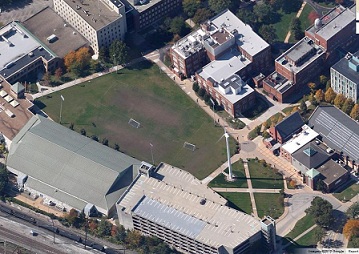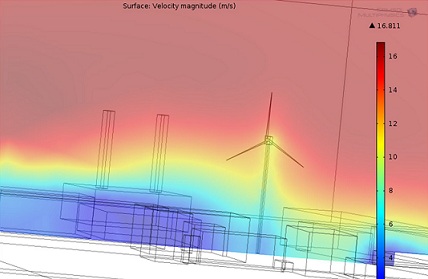
If I asked you to envision a wind turbine, odds are you’d picture a wind farm in some remote location. With good reason; that’s commonly where they are found. If you’re a student or faculty of Case Western Reserve University, on the other hand, you might think of the wind turbine you have on campus. Does it make sense to set up wind turbines in urban settings? These two researchers suggest that it does.

Wind turbine on the Case Western Reserve University campus in
Cleveland, OH. Image courtesy of Matheus Fernandes and David Matthiesen.
Problem Definition
For those of you who don’t know, the urban campus of Case Western Reserve University in Cleveland, OH is home to a research wind turbine. The turbine is surrounded by 20-40 meter tall buildings, which begs the question “is there a loss in energy generation due to turbulence caused by the buildings in this setting?” Matheus Fernandes and David Matthiesen decided to find out. Then they shared their findings at the COMSOL Conference 2012 in Boston, taking home the “Popular Choice” award for their poster.
Modeling Urban Wind Turbines
The researchers wanted to analyze and visualize the wind flow from all possible directions. Using COMSOL Multiphysics and the CFD Module, they were able to create a Computational Fluid Dynamics (CFD) model of their wind turbine problem. In order to ensure their computer model was correct, Fernandes and Matthiesen set up cup anemometers to take actual wind measurements. They found that there was reasonable agreement between the real and virtual wind results, with a max difference of 12%.
Using the 2D work plane feature in COMSOL, a footprint sketch of building locations and dimensions was drawn up. The width of each building was exaggerated somewhat, for conservative results of building effects on the turbine at hub height. (If there is no effect on the turbine by buildings of this breadth, there would be none for narrower buildings, such as the ones on-site, either). The wind turbine itself was created by a combination of regular blocks, cylinders, and a vertical extruded sketch for the shape of the blades. Then, the buildings’ effect on the wind profile was analyzed to determine their maximum height without affecting the wind turbine at hub height.

Wind velocity surface of the turbine area. Air flow induced from West 15m/s.
Wind speed is shown in color, the yellow boundary is below the blades indicating
that, at turbine blade height, the wind flow is not affected by the buildings.
Image courtesy of Matheus Fernandes and David Matthiesen.
Results
So constructing a wind turbine in an urban setting is indeed not a far-fetched idea. If the buildings and the turbine are of certain dimensions, there may be no energy loss due to turbulence. First, it’s of course wise to create a computer model to analyze the intended location to ensure that it is in fact viable.
To see how you can model this problem, and to get the full details of this research, download the “Wind Flow Modeling of Area Surrounding the Case Western Reserve University Wind Turbine” paper and poster.




Comments (0)